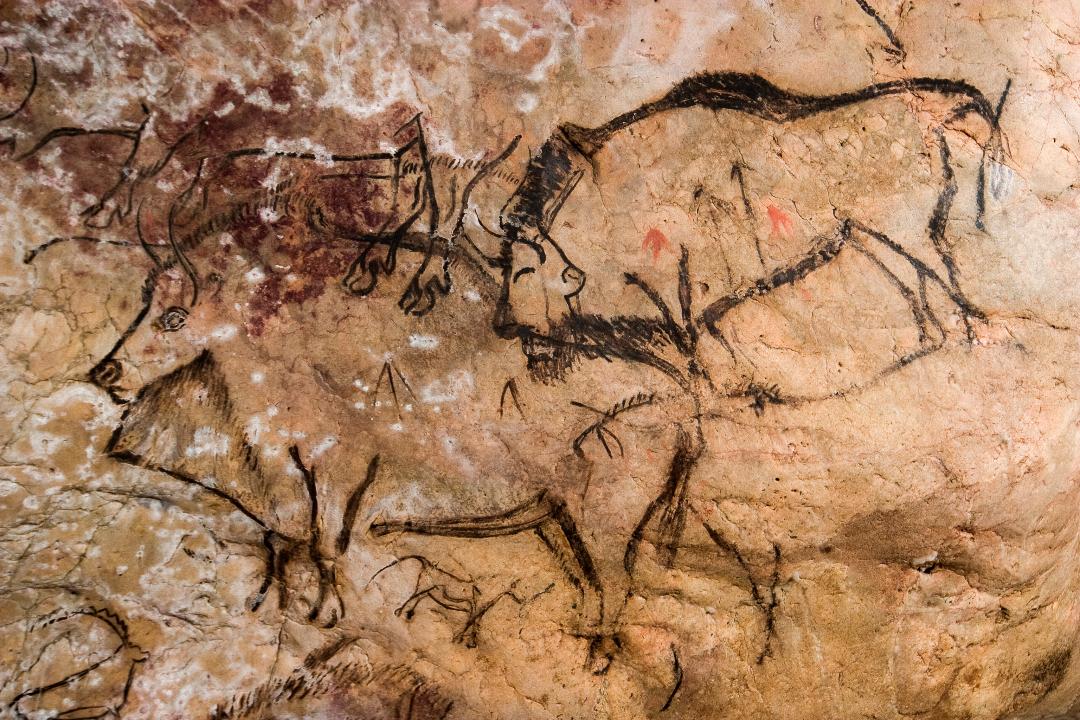Les Pyrénées ariégeoises sont l’un des berceaux de la préhistoire comme en témoignent les nombreux vestiges laissés par nos ancêtres. Il n’est qu’à voir la quantité de grottes ornées, sites archéologiques, cavernes, abris sous roche que compte le département. Si certains ne recèlent que des trésors géologiques tout à fait remarquables au demeurant, d’autres révèlent de nombreuses traces d’habitats, les plus emblématiques datant du Magdalénien, avec, comme point d’orgue la grotte de Niaux et son « Salon noir ».
La Grotte de Niaux
La grotte de Niaux est l’une des plus célèbres grottes ornées préhistoriques d’Europe. L’abbé Henri Breuil, spécialiste de l’art préhistorique, considérait qu’elle faisait partie des « six géants de la Préhistoire ». Et le préhistorien Leroi-Gourhan disait à son sujet que “Niaux est la seule grotte qui lutte avec Lascaux pour la qualité d’exécution et de conservation de ses oeuvres, par l’ampleur des compositions et le souffle qui les anime”.
Située face à la grotte de la Vache, à proximité de Tarascon, elle s’étend sur plus de deux kilomètres de galeries spacieuses et reste l’une des rares grottes ornées encore ouvertes au public. Une centaine de représentations animales et plusieurs centaines de signes ont été relevés sur les parois et sur le sol.
Dans une des galeries, on aperçoit des graffitis laissés par les visiteurs, le plus ancien datant de 1 602. Mais on peut surtout voir « le panneau des signes » sur lequel se concentrent de nombreux signes géométriques généralement peints en rouge, dont la signification reste encore mystérieuse. Ces signes sont également disséminés dans toute la grotte.
Bisons, chevaux, bouquetins et cerfs
L’apothéose reste le « Salon Noir », vaste rotonde avec une hauteur de voûte impressionnante. Dans cette salle majestueuse, sont concentrées 85 % des figurations animales. Elles sont groupées en six panneaux naturels, sur lesquels 70 animaux (bisons, chevaux, bouquetins et cerfs) sont distribués, avec une finesse d’exécution du trait et de disposition qui ne vous laisseront pas indifférent. Une des caractéristiques de ces figures est la représentation des détails de l’anatomie des animaux. Des conventions stylistiques concernant les pelages, les cornes ou la perspective des pattes des animaux se retrouvent fréquemment. Ces figures sont représentées de profil, sans ligne de sol, comme « suspendues dans l’air ». Une grande partie de ces dessins a d’abord été esquissée au charbon de bois tel un fusain, puis une véritable peinture à base de bioxyde de manganèse a été appliquée au pinceau.
Entre 17 000 et 16 000 ans avant notre ère
La composition des peintures et surtout les prélèvements directs de particules de charbon de bois ont mis en évidence qu’elles avaient été réalisées il y a entre 17 000 et 16 000 ans avant notre ère. Seule une partie de la grotte se visite (sur réservation), mais c’est un des rares sites à offrir encore l’émotion profonde de pouvoir mettre nos pas dans ceux de nos ancêtres à la lueur de lampes torches. Le réseau Clastres, qui la prolonge, reste interdit au public afin de protéger ces richesses inestimables (la fameuse belette, les pas d’un enfant gravés dans la glaise …) mais vous pouvez en voir une fidèle reproduction au parc de la préhistoire, situé à Tarascon, tout comme un fac similé du Salon Noir. Si vous voulez en savoir plus, vous pouvez lire les ouvrages du célèbre préhistorien ariégeois Jean Clottes (celui qui a authentifié la grotte Chauvet lors de sa découverte). Il n’y a pas meilleure introduction aux visites que son livre “Les Cavernes de Niaux, art préhistorique en Ariège”.
La Grotte de Mas d’Azil
Classée Monument Historique depuis 1942, la Grotte du Mas-d’Azil est reconnue comme un site exceptionnel par son impressionnante géologie et sa renommée archéologique. Il s’agit de la seule grotte d’Europe à être traversée par une rivière et une route. Elle est d’ailleurs site “éponyme” d’une période : l’Azilien.
Mammouths, rhinocéros laineux, ours des cavernes
Édouard Piette (l’un des premiers préhistoriens français de la fin du XIXe siècle) a fouillé la grotte à partir de 1887 et y découvre des grattoirs courts, des harpons plats en bois de cerf, des galets plats peints de figures schématiques à l’ocre rouge. C’est lui qui nomme “Azilien” la période qui les caractérise (vers 11 500 avant notre ère). Des ossuaires encore visibles dans les étages supérieurs ont livré de précieux renseignements sur les animaux de la faune des périodes froides et sur l’alimentation des Magdaléniens : mammouths, rhinocéros laineux, ours des cavernes, chevaux, rennes, bovidés, bouquetins… Important habitat préhistorique, la grotte renferme également plusieurs galeries ornées contenant d’intéressantes figures malheureusement non accessibles aux visiteurs. Entre 1901 et 1912, l’abbé Breuil et le Comte Bégouën découvrent des gravures ainsi que des peintures rouges et noires dans une petite salle suivie d’une étroite galerie nommée « Galerie Breuil ». Bisons, chevaux, cervidés, poissons, un possible félin et des signes géométriques s’y succèdent sur quelques dizaines de mètres. Les reproductions des dessins et gravures de ces galeries ornées sont visibles dans le Musée de la Préhistoire du Mas-d’Azil et au Centre d’Interprétation.
La grotte de Bédeilhac
C’est une caverne immense aux concretions stalagmitiques impressionnantes. Il y a 14 000 ans, Cro Magnon y laissa l’empreinte de sa main.
La grotte de la Vache
Située à Aliat, c’est le complément idéal des visites des grottes de Niaux et de Bédeilhac, elle fut le lieu de vie de Cro-Magnon, il y a 13000 ans. Elle livre aux archéologues des milliers d’objets: ossements et dents d’animaux, outils et armes, mais aussi de sublimes objets décorés tous plus fins et délicats les uns que les autres. Visiter cette caverne, c’est découvrir l’intimité et la vie de nos ancêtres chasseurs-cueilleurs.
C.D.
Préparer sa visite
- La Grotte de Bedeilhac
- La Grotte du Mas d’Azil
- La Grotte de Niaux
- La Grotte de la Vache
- Les Carvernes du Volp
- Tout savoir sur la préhistoire sur Hominides

